In this article, I show you 4 diffent ways of how to cook Sauerkraut from a bag.
I discuss the best ways to preserve the vitamins and lactic acid bacteria, as well as the best spices, how to make Sauerkraut taste less sour and how to make it more soft and sweet.
From serving Sauerkraut raw and uncooked, to cook it Granny-style for a long time (and everything in between!) - this article will help you to choose your favorite method to cook and serve Sauerkraut.
Jump to:
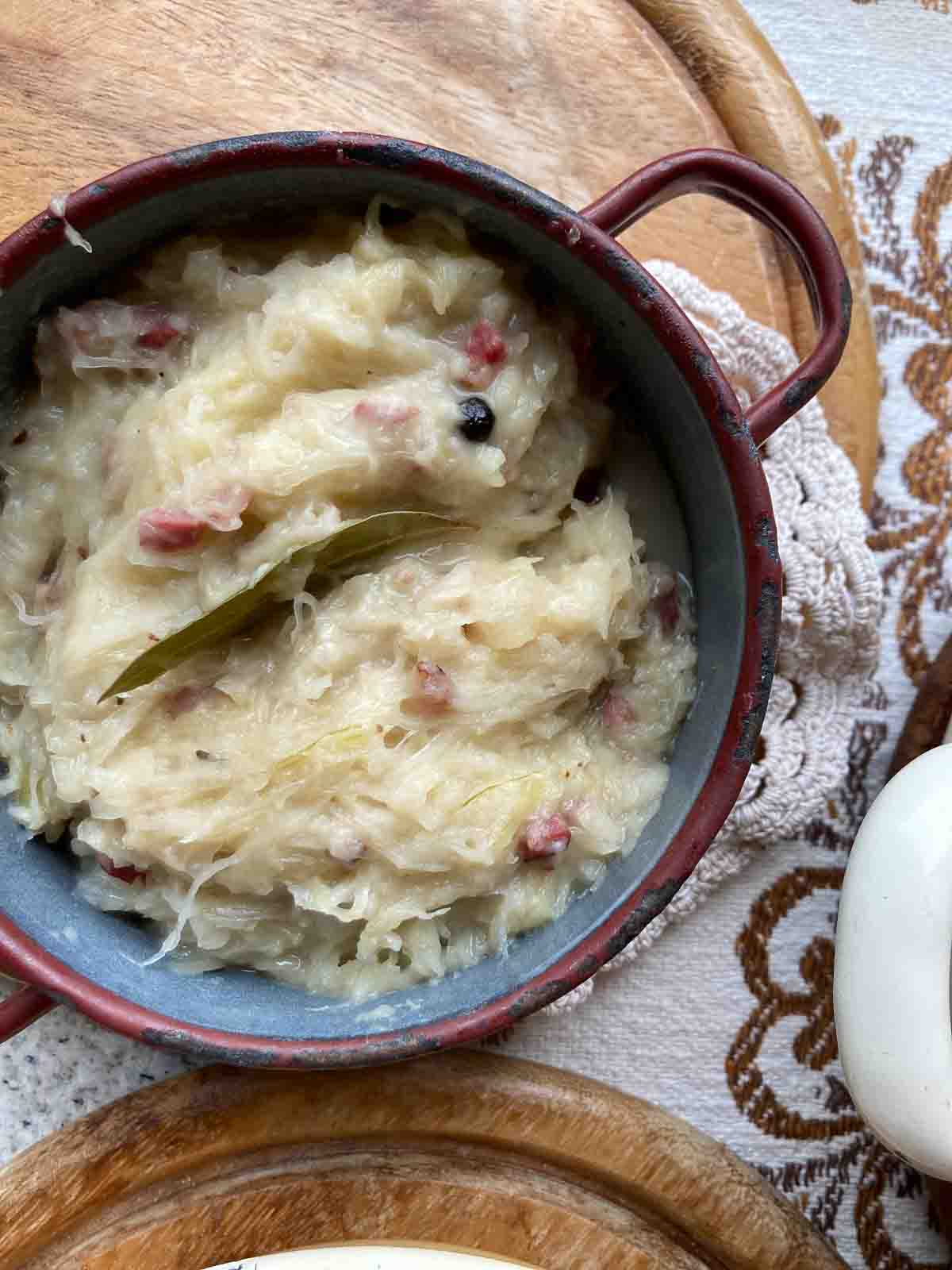
Health benefits of Sauerkraut
Sauerkraut (sour cabbage) is a type of fermented cabbage that has been popular in many cultures for centuries.
During the fermentation process, the cabbage is transformed by beneficial bacteria into a tangy and flavorful food that is not only delicious, but also packed with health benefits. Sauerkraut is rich in vitamins C and K, and also contains a variety of probiotics that can support gut health, boost the immune system, and reduce inflammation in the body. In addition, sauerkraut is low in calories and high in fiber, making it a great addition to any healthy diet.
Homemade Sauerkraut
If you want to make your own Sauerkraut at home, you can check out the directions on this recipe for homemade Sauerkraut from BBC. (However, I myself, failed a few times and the Sauerkraut always went bad. So I prefer to buy my Sauerkraut in the grocery store from now on ;D.)
The importance of the fermentation process
The fermentation process is a crucial step in making sauerkraut, as it is what gives the dish its signature tangy flavor and transforms the raw cabbage into a nutrient-rich, probiotic-packed food.
During the fermentation process, beneficial bacteria consume the natural sugars in the cabbage and convert them into lactic acid. This acidification process not only gives sauerkraut its tangy taste, but also helps to preserve the cabbage by creating an acidic environment that inhibits the growth of harmful bacteria.
In addition to the unique flavor profile and preservation benefits, the fermentation process also has a number of health benefits. As the bacteria break down the cabbage, they release enzymes and other beneficial compounds that can improve digestion, boost the immune system, and reduce inflammation in the body.
Overall, the fermentation process is a key aspect of making sauerkraut and plays a critical role in both its flavor and its health benefits.
Options for buying sauerkraut in the grocery store
In the grocery store, you can buy Sauerkraut usually in a bag or can. (Very rarely, you can even buy it from a big wooden barrel, as seen at an Austrian farmer's market and Hungarian supermarket a few years ago.)
Sauerkraut in a bag
Sauerkraut in plastic bags is usually raw and the most healthy option. But it can cause trouble if you have a sensitive gut. Then it is recommended you start by eating only very little at first, like a teaspoon or two. If this does not cause any stomach aches after a few hours, you can eat more the next day, and so on.
Bagged sauerkraut is typically sold in the refrigerated section of the grocery store and is often labeled as "fresh" or "raw". This type of sauerkraut is typically made using only cabbage and salt and has not been heated or pasteurized in any way. Because it is not cooked, raw sauerkraut has a crisp texture and a fresh, tangy flavor that many people find more appealing than the softer, more sour taste of cooked sauerkraut. Raw sauerkraut is also believed to contain higher levels of beneficial bacteria than cooked sauerkraut, making it a popular choice for those seeking the probiotic benefits of fermented foods.
However, not all oft he bagged Sauerkraut you can find in grocery stores is raw. Some are pasteurized and contain additives and additional acid to make it last longer. Check the packaging for a „raw“ or „unpasteurized“ label and make sure to buy good quality sauerkraut for a maximum of vitamins and lactic acid bacteria.
Sauerkraut in a jar
Jarred sauerkraut, on the other hand, is typically sold in the non-refrigerated section of the grocery store and is often labeled as "cooked" or "pasteurized". This type of Sauerkraut has been heated to kill off any potentially harmful bacteria and increase its shelf life, and may also contain additional ingredients like vinegar or sugar to enhance the flavor. While jarred sauerkraut can be a convenient option for those who don't have access to fresh Sauerkraut or prefer a softer, more sour taste, it may not contain as many beneficial bacteria as raw sauerkraut.
You can cook jarred Sauerkraut the same ways as Sauerkraut from a bag.
Jarred Sauerkraut can be stored at room temperature, while raw Sauerkraut in a bag is stored in the fridge.
Ultimately, the choice between bagged and jarred sauerkraut comes down to personal preference and dietary needs. For those seeking the highest levels of beneficial bacteria and a fresh, tangy taste, raw sauerkraut may be the way to go. However, jarred sauerkraut can be a convenient and tasty option for those looking for a simple side dish or ingredient to add to recipes.
How to cook Sauerkraut from a bag - 4 ways
There are a few ways how you can serve Sauerkraut from a bag. You can eat it cold and raw, heat it on a medium-low temperature or cook it longer, to make it soft.
1st and easiest way: Serve Sauerkraut raw
Raw Sauerkraut contains the highest amount of vitamins and beneficial lactic acid bacteria. You don’t necessarily have to cook Sauerkraut. It is even the most healthy and easy way to eat it uncooked. (if your gut is not too sensitive!)
Raw plain Sauerkraut is the perfect side dish to sandwiches, hot dogs, grilled meat, etc.
2nd (very easy) way: Warm up in pot
This is the most easy recipe to cook sauerkraut from a bag. It is also a vegan recipe (if you can call it a recipe at all):
You can warm up the Sauerkraut in a pot, without adding any spices or other ingredients. Warm/hot Sauerkraut fits to main dishes like spicy sausage, pork roast, dumplings, potatoes, etc.
This way to cook Sauerkraut is the most simple recipe. You don't have to add spices at all, but you can. Besides the bag of sauerkraut, you can add the following ingredients to the pot:
- 1 teaspoon of caraway seeds
- 3 juniper berries
- 1 bay leaf
- 3 corns of pepper
- 1 teaspoon of ground red pepper
- 1 tablespoon of sugar (or brown sugar)
- cubed bacon
- ½ cup vegetable, beef or chicken broth
- grated apple
- apple sauce
- grated carrots
Instruction:
Put Sauerkraut and juice in a large pot. Optionally, add spices and ingredients of choice. Warm up at medium temperature, until the Sauerkraut is hot. To preserve vitamins and lactic acid bacteria, don't bring to a boil.
To make most of the vitamins and lactic acid bacteria „stay“, be sure to only warm it up and never bring it to a boil. This way, the beneficial bacteria from the fermenting process will be preserved, while you still have a flavorful result.
To make the Sauerkraut less sour, you can drain the juice and rinse it in water before cooking. See next chapter in the article for detailed instructions on how to rinse Sauerkraut. This way it will taste less salty and sour but also contain fewer vitamins and healthy bacteria.
3rd way: Serve Sauerkraut with sauteed onion, spices and roux
You can make your Sauerkraut more flavorful by adding sauteed onion, spices and a white roux. This method is the best way to preserve the vitamins and probiotics, while at the same time adding lots of flavor and a wonderful soft consistency to your dish.
The exact quantities for this recipe are listed in the printable recipe card at the bottom of this article.
Jump to Printable Recipe CardIngredients
- bag of Sauerkraut
- neutral oil (alternatively butter, or even better, bacon drippings)
- onion
- sugar
- cubed bacon
- black pepper
- bay leaf
- juniper berries
- caraway seeds
- For the roux (optional):
- butter
- flour
- Extra Tipp: Grated apples or applesauce are a popular choice to make it sweeter (additionally or instead of sugar).
Instructions
Start by sauteeing onions in a large skillet with a tablespoon of butter. Caramelize the onion with a little sugar, and add a handful of cubed bacon and spices like black pepper, bay leaves, juniper berries.
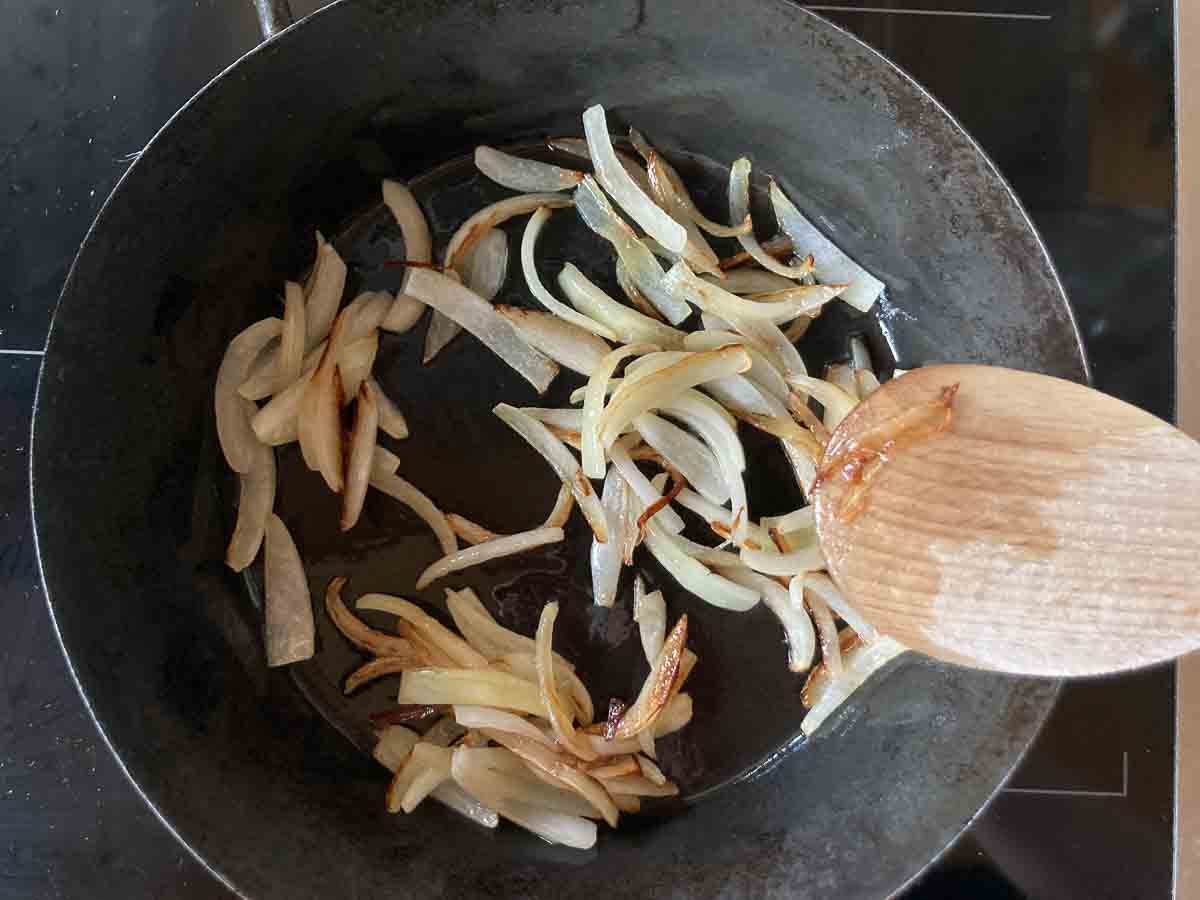
Drain and rinse the Sauerkraut, if you prefer it mild and less sour.
Add the Sauerkraut to your skillet. Add ½ cup of water or more, if there is not enough juice. Heat up on medium-low heat. Don't bring to a boil. This is the best way to ensure you keep the vitamins and probiotics.
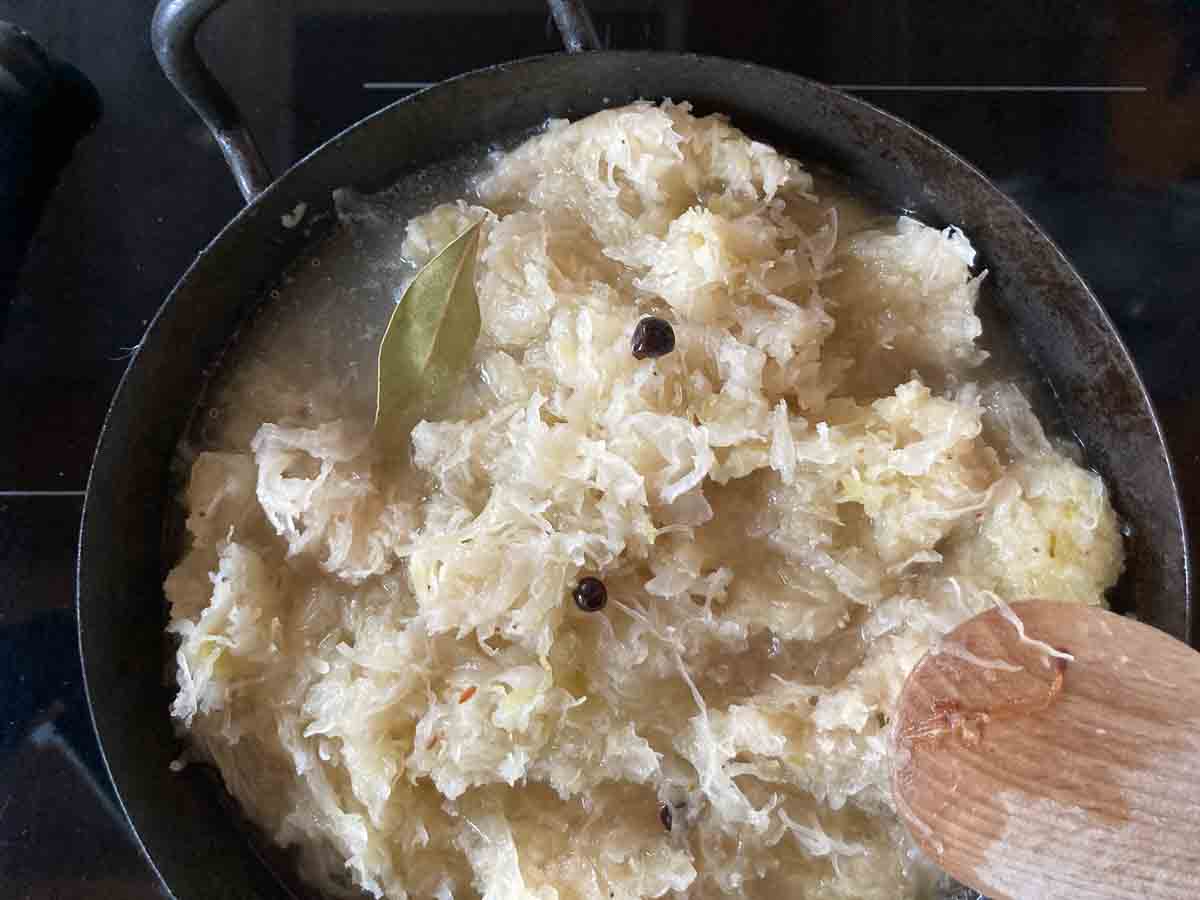
Optional: A white roux will result in a very nice consistency.
In a small pan, melt 2 tablespoons of butter. Add 2 tablespoons of flour and stir together well. Remove from the stovetop immediately. Voilà - You have your roux! Once the Sauerkraut is hot, stir in the roux and serve.
Do this at the very end of your cooking process, otherwise the roux will become dry.
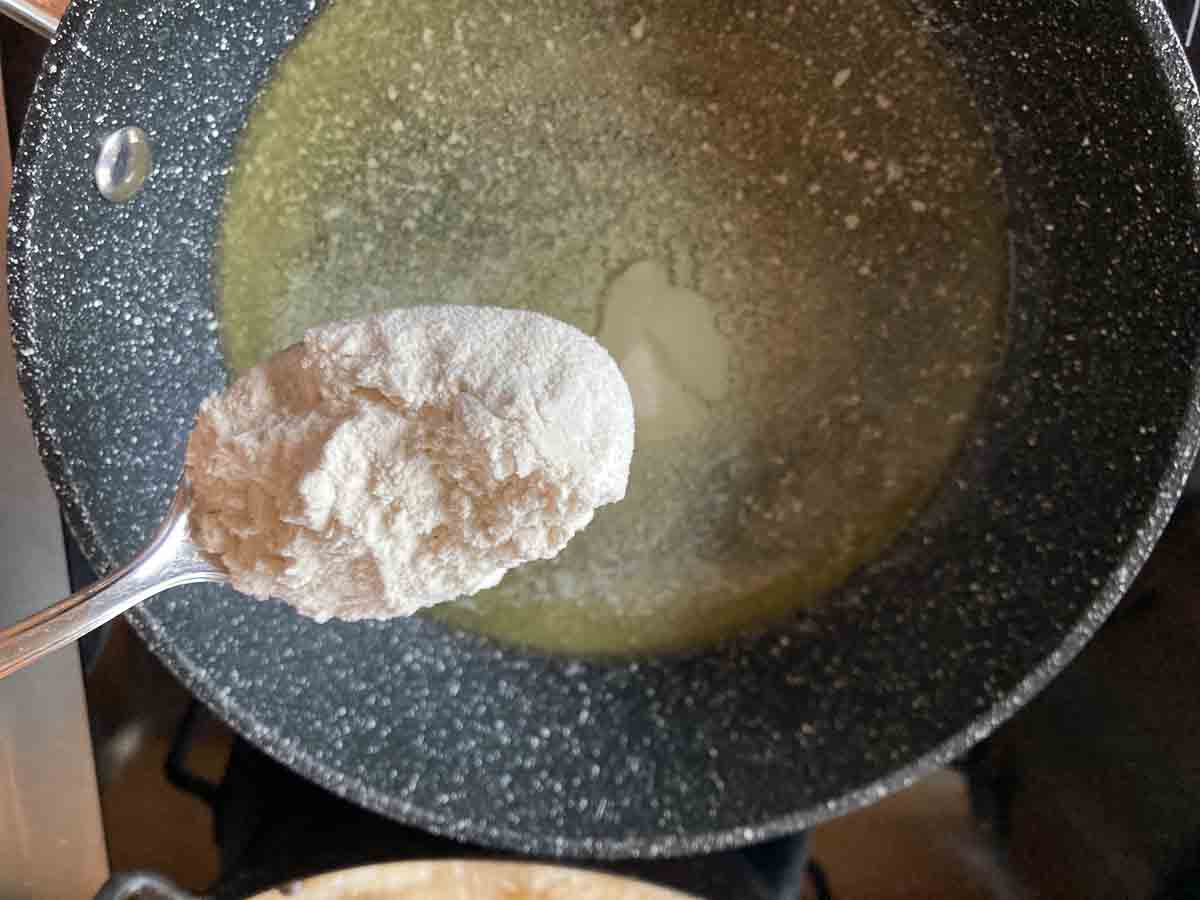
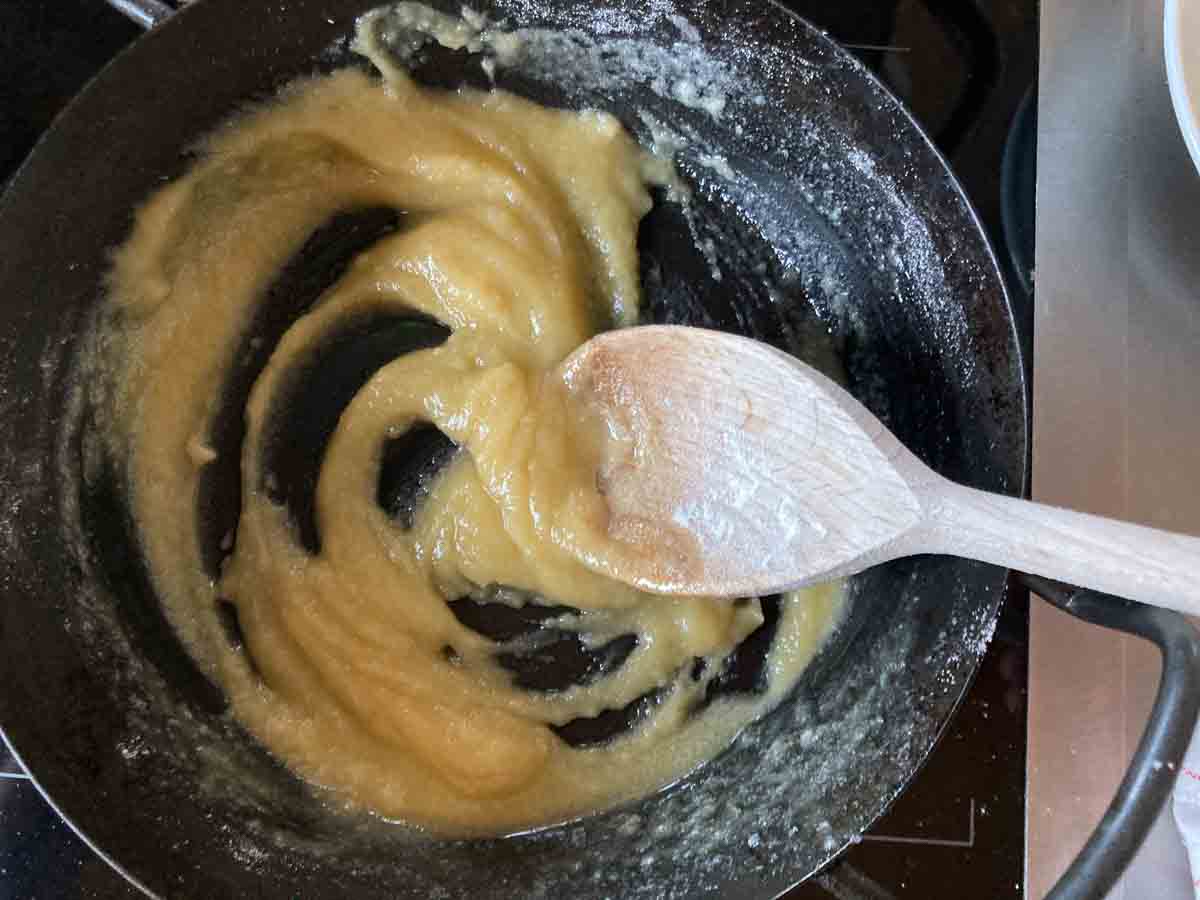
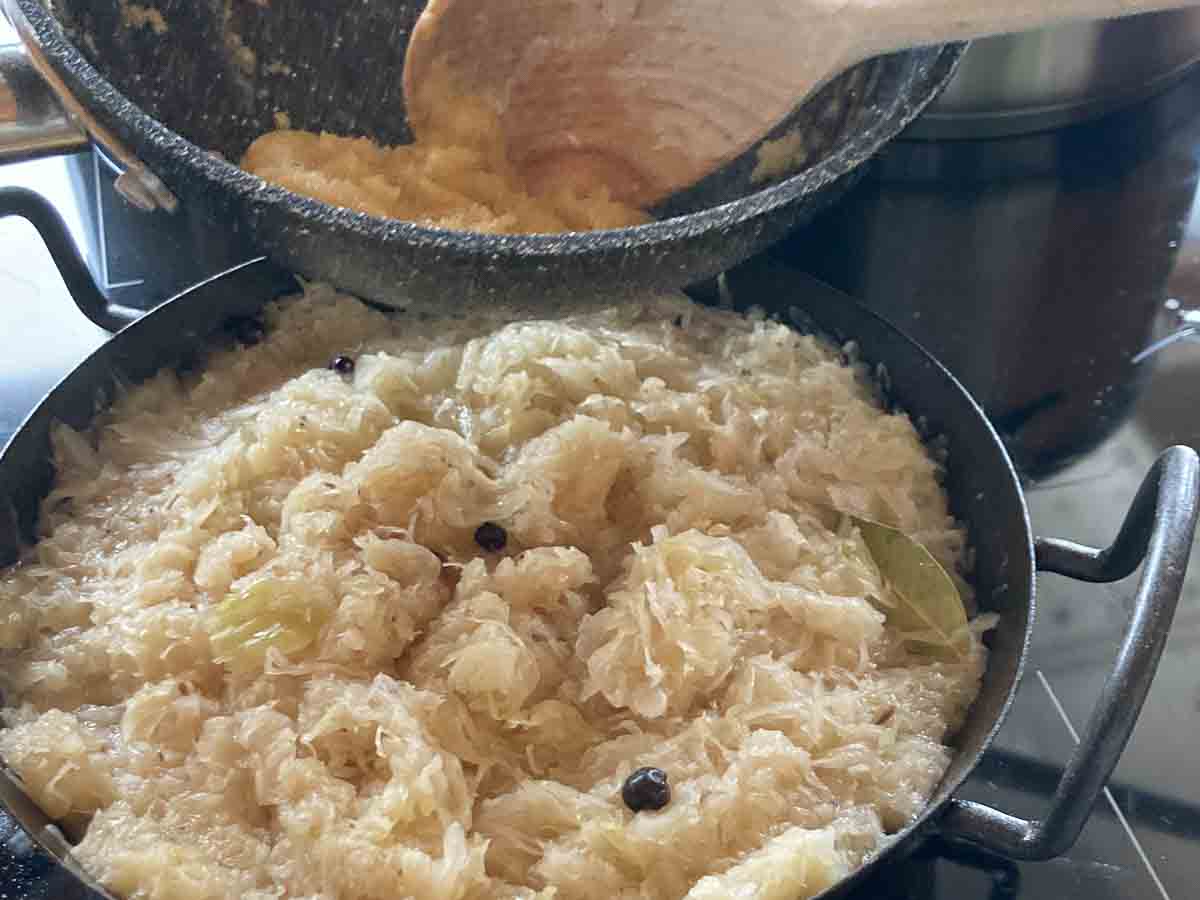
4th way: Cook Sauerkraut for 30-40 minutes
The most flavorful and soft Sauerkraut comes from cooking it on medium-high heat for about 30-40 minutes (together with sauteed onions, bacon, spices, etc.)
However, the long cooking time will destroy most of our vitamins and probiotics!
On the other hand, a softer and cooked Sauerkraut is easier to digest for sensitive guts and is less likely to cause stomach aches.
PLUS: ALL the Austrian and German grannies cook it that way - which means it's definitely what tastes best ;D.
For the softest and best Sauerkraut recipe (and my favorite way), please see my Viennese Grandmothers' Sauerkraut Recipe with sauteed onion, bacon, and easy roux.
Drain and Rinse Sauerkraut
To make the Sauerkraut less sour, you can drain and rinse it in a large bowl.
Open the bag or jar and pour the sauerkraut into the bowl. Next, fill the bowl with cool water and use your hands to gently agitate the sauerkraut, breaking apart any clumps and allowing the water to flow through. Finally, pour the sauerkraut into a colander to drain away the water, using your hands or a spoon to press out any excess liquid.
Sauerkraut shelf life
Sauerkraut has a long shelf life due to its fermentation process, which creates an acidic environment that inhibits the growth of harmful bacteria.
Jarred sauerkraut can typically last for several months or even up to a year or longer when stored in a cool, dry place. As soon as you open the jar, you have to store it in the fridge, where it will last for a few more weeks.
Raw sauerkraut (& homemade Sauerkraut in a jar) may have a shorter shelf life, usually around 4 weeks. (Check for expiration date if store-bought.) Homemade Sauerkraut in a Sauerkraut wooden barrel, when prepared and stored the right way, should also have a shelf life of 6-12 months.
To maximize the shelf life of sauerkraut, it should be stored in an airtight container and refrigerated after opening.
Cooked Sauerkraut with sauteed onions, bacon, roux, etc. however, can only be stored in the fridge for about 3 days.
Cooked sauerkraut (see recipe) can be frozen for a few months. To thaw, leave it in the fridge overnight and cook in a saucepan the next day.

Sauerkraut Recipe To Preserve Vitamins and Probiotics
Kochutensilien
- large bowl (optionally, to drain and rinse Sauerkraut)
- sieve, colander
- skillet pan
- small pan (optionally, for white roux)
Zutaten
- 1 tbsp. oil alternatively butter, or even better, bacon drippings
- 1 onion sliced
- 1 tbsp. sugar or brown sugar
- 3-4 tbsp. cubed bacon
- 3 corns of black pepper
- 1 bay leaf
- 3 juniper berries
- 1 tsp. caraway seeds
- 1 bag Sauerkraut ~ 16 oz / 450 gram
- 1 small apple, grated or 6 tbsp. apple sauce
For the roux:
- 2 tbsp. butter
- 2 tbsp. flour
Anleitung
- Peel onion and cut it into thin slices or cubes. In a large skillet, saute onion on medium temperature with a tablespoon of oil, until soft and brown.
- Add bacon and sugar and let caramelize for a minute.
- Add spices. Grate the apple and add to the pan.
- Drain and rinse the Sauerkraut with water in a large bowl, if you prefer it mild and less salty and sour. (Sometimes the Sauerkraut tastes mild without draining it. Best have a taste before draining and rinsing it.)
- Add the Sauerkraut to your skillet. Add ½ cup of water or more, if there is not enough juice. Heat up on medium-low heat. Don't bring to a boil. This is the best way to ensure you keep the vitamins and probiotics.
- Optional: A white roux will result in a very nice consistency. In a small pan, melt the butter. Add the same amount of flour and stir together well. Remove from the stovetop immediately. Once the Sauerkraut is hot, stir in the roux and serve.
(c) by Angelika Kreitner-Beretits / Vienna Sunday Kitchen
April 19, 2023 Hast du das Rezept ausprobiert? Dann freue ich mich über deine Bewertung!! / Rate this Recipe!

Ich freu mich über deine Rückmeldung zum Rezept in den Kommentaren!